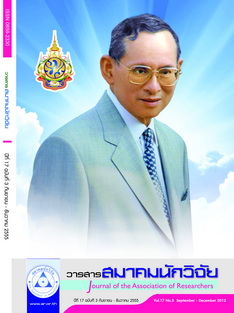FIVE-FACTOR OF PERSONALITY, RISK PERCEPTION BASED ON HEALTH BELIEF MODEL AND SAFETY DRIVING BEHAVIOR OF BUS DRIVERS: A CASE STUDY OF A PRIVATE BUS COMPANY
Main Article Content
Abstract
The objectives of this research were: firstly, to compare safety driving behavior classified by personal data; secondly, to study the relationships between five-factor of personality, risk perception based on health belief model and safe driving behavior of bus drivers; finally, to study five-factor of personality and risk perception based on health belief model could predict safety driving behavior of bus drivers. The sample of 201 bus drivers was selected from a private bus company. Data were collected by using questionnaires and analyzed by a statistic computer program. Percentage, mean, standard deviation, t-test, F-test, Pearson's product-moment correlation coefficient, and multiple regression analysis were adopted for data analysis. Results showed that: firstly, there was no significant difference in safety driving behavior of bus drivers who were different in term of age, marital status, education level, working experience, driving experience, and accident experience; secondly, the extraversion, openness to experience, agreeableness, conscientiousness personality and risk perception based on health belief model were positively related to safe driving behavior at the .01 level; and finally, perceived benefits and the conscientiousness could predict 49.1% of safe driving behavior of bus drivers at the .01 level.
Article Details
บทความที่ปรากฏในวารสารนี้ เป็นความรับผิดชอบของผู้เขียน ซึ่งสมาคมนักวิจัยไม่จำเป็นต้องเห็นด้วยเสมอไป การนำเสนอผลงานวิจัยและบทความในวารสารนี้ไปเผยแพร่สามารถกระทำได้ โดยระบุแหล่งอ้างอิงจาก "วารสารสมาคมนักวิจัย"
References
ณรงค์ ณ เชียงใหม่. (2532), อุบัติวิทยา. กรุงเทพฯ: โอเดียนสโตร์,
ณัฐพล พัฒนชัยกุล. (2548). การศึกษาพฤติกรรมการป้องกันอุบัติเหตุจากการขับขี่รถจักรยานยนต์ ของนักศึกษามหาวิทยาลัยราชภัฏเลย. วิทยานิพนธ์ศิลปศาสตรมหาบัณฑิต, มหาวิทยาลัย ราชภัฏเลย.
ทรงพล ภูมิพัฒน์. (2538) จิตวิทยาสังคม. กรุงเทพฯ: เอส.อาร์.พริ้นติ้ง
ธนวิทย์ กลิ่นทอง. (2547). อิทธิพลขององค์ประกอบห้าประการของบุคลิกภาพและการรับรู้แบบแผน ความเชื่อด้านสุขภาพที่ส่งผลต่อพฤติกรรมการทํางานที่มีความปลอดภัยของพนักงานซ่อม บํารุงอากาศยาน, วิทยานิพนธ์วิทยาศาสตรมหาบัณฑิต, มหาวิทยาลัยรามคําแหง
ธัชพงศ์ รุ่งเรือง. (2549). การรับรู้ความเสี่ยงกับพฤติกรรมความปลอดภัยในการใช้ยานพาหนะของ พนักงานขับรถขนส่งขนาดใหญ่ของบริษัทผลิตและจําหน่ายเครื่องดื่ม. วิทยานิพนธ์ วิทยาศาสตรมหาบัณฑิต, มหาวิทยาลัยเกริก.
นงรัตน์ เหล่าสุริยงค์. (2540), การประยุกต์ทฤษฎีแรงจูงใจในการป้องกันโรคในการปรับเปลี่ยน พฤติกรรมการขับขี่รถจักรยานยนต์ของนักเรียนมัธยมปลาย จังหวัดน่าน, วิทยานิพนธ์ วิทยา ศาสตรมหาบัณฑิต, มหาวิทยาลัยมหิดล
ประภาเพ็ญ สุวรรณ และสวิง สุวรรณ. (2534), พฤติกรรมศาสตร์ พฤติกรรมสุขภาพและสุขศึกษา กรุงเทพฯ: จุฬาลงกรณ์มหาวิทยาลัย.
เพ็ญแข แสงแก้ว. (2541). การวิจัยทางสังคมศาสตร์, กรุงเทพฯ: โรงพิมพ์มหาวิทยาลัยธรรมศาสตร์
มณีวรรณ ศรีสวัสดิ์. (2547). พฤติกรรมการป้องกันอุบัติเหตุจากการทํางานของช่างพิมพ์ โรงพิมพ์สิ่ง พิมพ์ประเภทกระดาษ พื้นที่เขตพระนคร. วิทยานิพนธ์วิทยาศาสตรมหาบัณฑิต มหาวิทยาลัย เกษตรศาสตร์
รัชยา รัตนะถาวร. (2546). ปัจจัยที่ส่งผลต่อพฤติกรรมการป้องกันอุบัติภัยจากการขับขี่รถ จักรยานยนต์ของนักเรียนมัธยมศึกษาตอนปลาย สังกัดกรมสามัญศึกษา ในเขตอําเภอเมือง จังหวัดปราจีนบุรี, วิทยานิพนธ์วิทยาศาสตรมหาบัณฑิต, มหาวิทยาลัยเกษตรศาสตร์,
ศรัณย์ คลังชํานาญ. (2549). ความสัมพันธ์ระหว่างเชาวน์อารมณ์ บุคลิกภาพห้าองค์ประกอบ กับผล การปฏิบัติงานของพนักงานระดับปฏิบัติการในกลุ่มธุรกิจพืชครบวงจร เครือเจริญโภคภัณฑ์ วิทยานิพนธ์วิทยาศาสตรมหาบัณฑิต, มหาวิทยาลัยเกษตรศาสตร์,
โสภา ชูพิกุลชัย. (2532), ความรู้เบื้องต้นทางบุคลิกภาพอันมีแนวโน้มต่อการประกอบอาชญากรรมใน ประเทศไทย. กรุงเทพฯ: คณะสังคมศาสตร์และมนุษยศาสตร์ มหาวิทยาลัยมหิดล
สํานักงานตํารวจแห่งชาติ. (2554). สถิติอุบัติเหตุจราจรทางบก, ค้นเมื่อ 29 มิถุนายน 2554, จาก www.statistic.ftp.police.go.th/stat/traffic_main.htm. 2552
สุมน นานาพูลสิน. (2550). ผลของบุคลิกภาพห้าองค์ประกอบที่มีต่อพฤติกรรมความปลอดภัยในการ ทํางาน: กรณีศึกษาพนักงานระดับปฏิบัติการ บริษัทปูนซิเมนต์ไทย (ท่าหลวง) จํากัด วิทยานิพนธ์ศิลปศาสตรมหาบัณฑิต, มหาวิทยาลัยธรรมศาสตร์
Alparslan, B. et al. (2000). The relationship between traffic accidents with personality traits. Journal of Safety Research, 31,(4), 253-256.
Arthur, W. Jr., & W. G. Graziano. (1996). The five-factor model, conscientiousness, and driving accident involvement. Journal of Personality, 64(3), 593-618.
Becker, H. M. (1974). The health belief model and sick role behavior. Health Education Monograph, 2(4), 409-417.
Clarke, S., & Robertson, I. T. (2005). A meta-analytic review of the big five personality factors and accident involvement in occupational and non-occupational settings. Journal of Occupational and Organizational Psychology, 78(3), 355 376.
Costa, P. T. & Widiger, T.A. (1994). Personality disorders and the five-factor model of personality. Washington D. C.: American Psychological Association.
Dahlen, E. R. & White. R. P. (2006). The big five factors, sensation seeking, and driving anger in the prediction of unsafe driving. Personality and Individual Difference, 41(5), 903-915.
Florio, A. E., Alles, W. F. & Stafford. G. T. (1979). Safety Education. (feed.) New York: Mcgraw Hill Book.
Lupton, D. (1999). Risk. London: Routledge Taylor & Francis Group.
Mount, M. K., Barrick, M. R. & Stewart, G. L. (1998). Five-factor model of personality and performance in jobs involving interpersonal interactions. Human Performance, 11(2/3), 145-166.
Rosenstock, I. M. (1974). Historical origins of the health belief model. Health Education Monographs, 2(4), 328-335.
Sabey, B. E. & Taylor, H. (1980). The known risks we run: The highway.
In R. C. sketching and W. A. Albers. (eds.). Societal risk assessment: How safe is safe enough?. New York: Springer. Scholl, W. R. (2003). The Big 5 Approach to Personality Assessment. The University of Rhode Island. Retrieved March 20, 2008, from www.cba.uri.edu/scholl Notes/ Big_Five.html.


